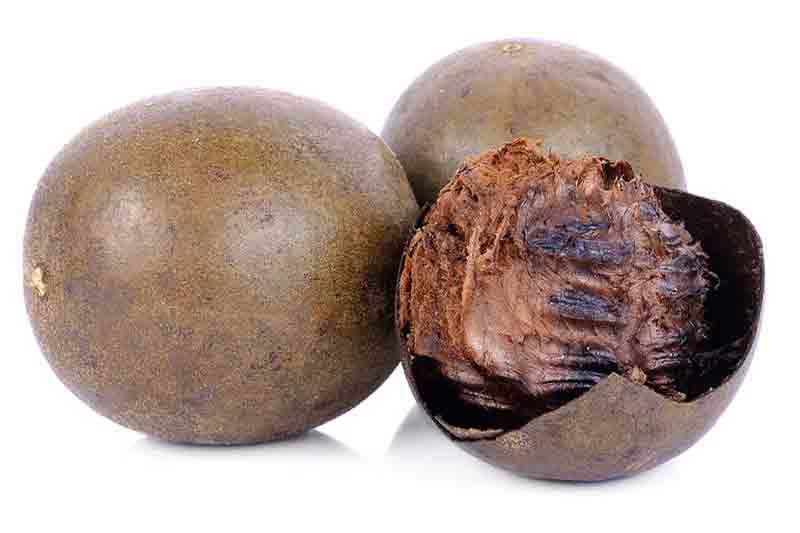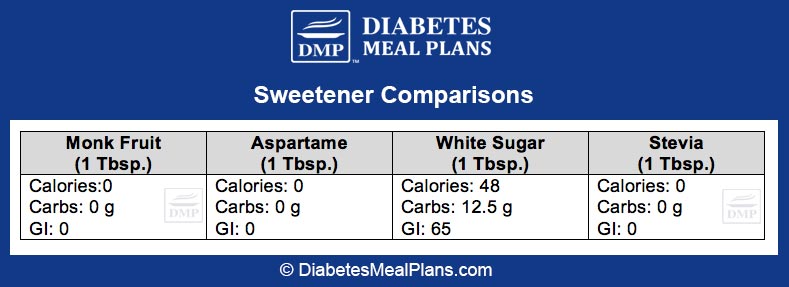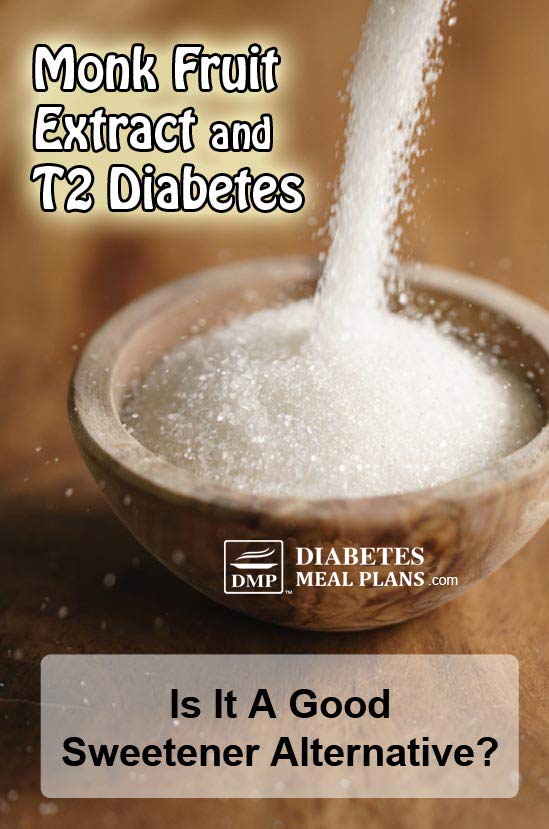Have you heard that monk fruit extract might be a good sweetener for type 2 diabetes?
As it turns out, it actually is. So let’s learn more about it.
What is Monk Fruit Extract?
Monk fruit is a small melon that naturally grows in Asian regions like southern China and northern Thailand. The extract from this fruit is very sweet and it’s been used in Chinese households for thousands of years.

Monk fruit also has a role in traditional Chinese medicine for soothing sore throats and relieving the common cold.
Chinese immigration brought monk fruit to the U.S. in the 1940’s and its popularity as a low calorie sweetener has spread across the world from there. It is now readily available in health food stores and supermarkets in many countries—how convenient!
Fresh monk fruit can spoil very quickly so you will only see it on a grocery store shelf in the form of monk fruit extract, which has been processed. You can find it in both a liquid and a powered form.
Nutrition Facts
Amazingly, monk fruit extract is 300 to 400 times sweeter than cane sugar (white sugar) so a little can go a long way!
A typical serving size for the powered extract is 1/8 teaspoon and that tiny amount is more than enough to sweeten drinks, desserts, and smoothies.
Monk fruit contains no calories, fats, protein, or carbs.
As a diabetic, you really want to watch your carbohydrate intake because the amount of carbs you eat has the biggest influence on blood sugar and A1c levels.
Considering monk fruit is zero carbs, it is a great alternative to regular sugar.
The extract of this little fruit also has a glycemic index of zero—so it does not raise your blood sugar at all—yet another bonus!
Comparing Sweeteners
If you compare one tablespoon of monk fruit extract to other low carb sweeteners you’ll notice that it has the same amount of calories, carbs, and glycemic index as both stevia and aspartame.

White sugar is clearly the loser as it has the most carbs, it has the highest glycemic index, and it packs almost 50 empty calories to boot.
But white sugar aside, are all zero carb sweeteners created equal? Why pay for some fancy monk fruit extract when you can find fake sweeteners like aspartame for dirt cheap?
Keep reading to find out…

Myths and Truths
Myth: All alternatives sweeteners are the same because they have zero carbs and don’t raise your blood sugar. Any alternative sweetener is automatically healthier than real sugar.
Truth: This is not always the case. For example, alternative “natural” sweeteners like coconut sugar and agave syrup are not any healthier for a diabetic than regular sugar.
These alternatives still contain lots of carbs and fructose, which aren’t conducive to a healthy diabetic diet. You should also be weary of artificial sweeteners like aspartame, because they are linked to other health problems – weight gain, fatty liver and inflammation, to name a few.
Natural or not, you can’t lump all “alternative sweeteners” together and say they are healthier overall, especially in terms of type 2 diabetes.
It’s important to ignore the hype around popular health trends and do your homework on each product before adding it to your diet.
However, the good news is that monk fruit extract is a good alternative sweetener that doesn’t appear to have any negative side effects.
Research on Monk fruit Extract
It’s amazing how many health boosting properties are packed into these unusual fruits. As mentioned earlier, monk fruit has been used for centuries to fight infections and allergies in traditional Chinese medicine.
It has antihyperglycemic properties that gently lower blood sugar levels in the body. Monk fruit also contains an antioxidant compound called “mogroside,” which has been associated with improved insulin release from the pancreas.
The antioxidants from the mogrosides exhibit powerful free radical scavenging ability that protects DNA from oxidative damage.
One study showed that rats given monk fruit extract had a less dramatic increase in blood glucose after eating sugar. This study suggested that monk fruit extract may also prevent blood sugar spikes in humans, which would be a huge win for diabetics.
Studies have shown that the mogrosides found in monk fruit extract also have a “cooling effect” that is anti-inflammatory within the body. These anti-inflammatory effects may further improve type 2 diabetes and reduce risk of developing cancer or other chronic diseases.
The Conclusion on Monk Fruit
Overall, monk fruit extract can be a good choice for diabetics who are looking to sweeten up a meal or make a sweet treat.
It may seem like a little bit of extra work to hunt down suitable alternatives to sugar, but reducing carbs is one of the most important aspects of managing your condition over the long term.
Stevia is another good choice because like monk fruit, it contains no carbs, it doesn’t raise blood sugar, and research supports its effectiveness for diabetics – without any negative side effects.
Please pin, tweet or share this info to help others. Thanks!

Hi! I really prefer Splenda but where does Splenda fall in terms of sweeteners and also compared to Stevia which I don’t like. Stevia is often mixed with dextrose too!
Of all the artificial sweeteners, splenda is probably your best option. Stevia would be a more natural option, but if it’s not something you like then there is no sense in using it!
Hey Emily. I thought of a question about oranges. If I were to eat all of am organic orange and carefully chew up the peel along as I eat the orange fresh, for flavors sake,should our bodies be able to digest the peel? Or should I put the peel in my Nutribullet first,or zest the orange peel? I want to benefit from the pith too,and just the flesh,or just a little bit of zest.
Interesting question! Oranges are a bit higher in carbohydrate, so for best blood sugar control you would probably want to reduce your intake of this fruit in general. But as far as the peel.. it is thought your body should be able to digest some peel, if eaten in small amounts. Eating a large amount could cause stomach discomfort. Alternatively zesting or putting into a smoothie could make it a little easier on your body if you are prone to digestive troubles.
What can be used when baking rusks?
I had never heard of rusks until you asked, but based on my quick Google search it appears you are referring to something that resembles at biscuit or bread?
Being that I’ve never had them I am not able to provide a good recipe or substitution, but you may be able to use some almond flour or coconut flour to create something similar. Let us know if you find a successful low carb recipe, we would love to give it a try!
Hey Janice thank you for your wonderful articles I look forward to receiving your free food list and the other publications. I requested them a couple of days ago and wonder if’s it takes a week or 10 days to see them in my an email. Or is there another step in verification that I missed
I love you’re down-to-earth comments in the fact that you don’t mind repeating yourself over And over what patient you must have
Cheers
Larry
Larry, please contact our support page for help with the newsletter and food lists.
What brands do you recommend?
None in particular Amber, that is your personal preference. We tend to use liquid stevia extract most of the time.
Liquid stevia is the best.